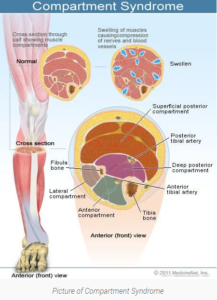Understanding Compartment Syndrome: What is it and How to Recover
Article Featured on Medicinenet.com
Compartment syndrome is a serious condition that occurs when there’s a large amount of pressure inside a muscle compartment. Learn more about this syndrome including symptoms, diagnosis, treatment options, and more.
Compartment syndrome facts
- Compartment syndrome describes increased pressure within a muscle compartment of the arm or leg. It is most often due to injury, such as fracture, that causes bleeding in a muscle, which then causes increased pressure in the muscle. This pressure increase causes nerve damage due to decreased blood supply.
- Symptoms include severe pain, numbness, and decreased range of motion.
- Surgery (fasciotomy) is the only treatment for acute compartment syndrome. The muscle compartment is cut open to allow muscle tissue to swell, decrease pressure and restore blood flow.
- Complications may include muscle loss, amputation, infection, nerve damage, and kidney failure.
- Prevention efforts include ice and elevation of the affected extremity.
- Chronic compartment syndrome usually requires no treatment or surgery.
What is compartment syndrome?
Compartment syndrome is a condition that occurs when injury causes generalized painful swelling and increased pressure within a compartment to the point that blood cannot supply the muscles and nerves with oxygen and nutrients. Muscles in the forearm, lower leg and other body areas are surrounded by fibrous bands of tissues. This creates distinct compartments. The fibrous tissue is very inflexible and cannot stretch to accommodate the generalized swelling. If left untreated, muscles and nerves fail and may eventually die.
While most often occurring in the forearm and lower leg, compartment syndrome can rarely occur in other parts of the body that have muscles contained in compartments, including the hands and feet.
Compartment syndrome may occur acutely due to swelling that arises from injury, or it may be chronic because of exertion such as exercise.
What causes compartment syndrome?
Muscles are contained in compartments covered by thick fibrous bands of tissue or fascia. Because of injury, pressure can increase within the compartment to swelling (fluid accumulation) or bleeding. In non-contracting muscle, the compartment pressure is normally about 0-15 mmHg of pressure. If the pressure within the compartment increases (usually greater than about 30 -45mmHg; or are within 30 mm of the diastolic blood pressure) most individuals develop compartment syndrome. When these high compartment pressures are present, blood cannot circulate to the muscles and nerves to supply them with oxygen and nutrients. Symptoms such as pain and swelling will result.
As the muscle cells lose their blood and oxygen supply, they begin to die. If the condition is not recognized and treated, the whole muscle can die, scar down, and contract. Similarly, nerve cells that are damaged may fail causing numbness and weakness in the structures beyond the injury site. If infection or necrosis develops, the individual may need the limb amputated to prevent death.
What are the risk factors for compartment syndrome?
Acute compartment syndrome occurs as a complication of an injury. Often it is due to a fracture of the radius or ulna in the forearm or the tibia and fibula in the lower leg that causes significant bleeding in one or more of the compartments. Bleeding can also be due to a badly bruised muscle. Crush injuries may cause both bleeding and swelling of a muscle.
Some injuries can be more subtle. If a person is incapacitated and immobile for a prolonged period of time, for example, due to alcohol or drug intoxication, swelling or muscle damage may occur because a blood vessel was compressed. The weight of an object (or the weight of the body itself) compressing a muscle group can cause rhabdomyolysis (muscle breakdown).
Compartment swelling may occur after the blood supply is re-established (reperfusion swelling) to an area that has lost it for a period of time. Two examples are: 1) a person is in an auto accident where their legs are trapped and compressed with heavy debris, which are subsequently freed from the debris after a period of time; 2) when a blood vessel is damaged and subsequently repaired through surgery.
Compartment syndrome may be a complication of bandages or casts that are applied too tightly, or due to swelling that occurs after casting.
Other abrupt causes of compartment syndrome include burns, snake bites and other envenomation, and anabolic steroid use. Individuals taking anticoagulants have a higher risk for compartment syndrome after trauma due to bleeding that cannot clot normally. Because there is some controversy about when fasciotomy is required (especially with snake bites) immediate consultation with a surgeon is recommended by most experts.
Chronic compartment syndrome occurs because of excessive exercise, where repetitive motion and muscle use cause localized swelling and irritation. Most often, symptoms in the legs are seen with runners and bicyclists and in the arms of swimmers. Symptoms resolve with rest and very rarely progress to an acute limb threatening situation.
What are the symptoms and signs of compartment syndrome?
The symptoms of compartment syndrome, plus the circumstances that led to their development assist to make the clinical diagnosis. Pain out of proportion to the injury (or physical examination of the muscle compartment) often is the clue to make the diagnosis of compartment syndrome. Increased pressure within the muscle compartment causes loss of blood supply and nerve inflammation. This causes significant pain and numbness or paresthesia. (para=abnormal + ethesia=feeling).
The diagnosis should be always considered when there is either an associated fracture, high velocity injury like a gunshot wound or a crush injury. Individuals who are taking anticoagulant medications such as warfarin (Coumadin) or enoxaparin (Lovenox) are at higher risk for bleeding into a compartment spontaneously or after injury.
Historically, the mnemonic memory device for compartment syndrome is the “5 Ps” (pain, paresthesia [change in sensation], pallor [pale coloration], paralysis, and poikilothermia [inability to control temperature]; some authors include pulselessness), but this should not be relied upon to make a diagnosis. Only pain and change in sensation (parathesia) may be symptoms that point to the diagnosis of a developing compartment syndrome.
Examination of the extremity often reveals tense and shiny skin that may be significantly bruised. Pain occurs with minimal range of motion of the foot, hand, or any of the extremity with compartment syndrome. The patient may have difficulty moving the extremity without assistance and pain is provoked when the care practitioner takes the affected limb though any range of motion
In chronic compartment syndrome, there may be pain with range of motion of the extremity and muscle bulging may be noticed. Numbness is common but all symptoms usually resolve within a few minutes of discontinuing exercise.
When should I seek medical care for compartment syndrome?
Acute compartment syndrome is a true emergency. If the pressure within the compartment is not released within a few hours, permanent muscle and nerve damage may occur.
Medical care should be accessed when numbness, tingling, weakness, or excessive pain occurs after an injury. While compartment syndrome is most often due to injuries of the forearm and lower leg, it may also occur in the hand, foot, or buttocks after a broken bone or crush injury.
How is compartment syndrome diagnosed?
While it is uncommon, the health care practitioner has to have a high index of suspicion for acute compartment syndrome if a patient presents with excessive pain, numbness, and a tense extremity after an injury. The patient’s history of an injury to the extremity often is all that is necessary for a diagnosis.
While blood tests may be ordered to look for chemical markers of muscle injury (for example, myoglobin and lactate levels) and kidney damage, the definitive diagnosis of compartment syndrome is confirmed by measuring the pressure within the compartments of the affected limb. A sterile needle is inserted directly into the muscle compartment and attached to a pressure monitoring device (see second-last reference for picture). Usually, pressure measurements (see values listed above) are taken in each compartment in the affected limb and this may require multiple needle sticks.
Chronic compartment syndrome may be diagnosed clinically but compartment pressures may be measured before and after exercise to confirm the diagnosis. The health care professional should also explore other potential causes of pain due to exercise, including stress fractures, shin splints, or tendon inflammation.
What is the treatment for compartment syndrome?
Prevention is the first step in the treatment of compartment syndrome. Significant injuries of the arms and legs that require casting or splinting should always be elevated and iced to minimize the potential for swelling. Elevation should be above the level of the heart. Ice therapy may even be considered even if a cast or splint has been placed.
Chronic or exercise induced compartment syndrome rarely requires any treatment; the pain and other symptoms usually stop minutes to hours after the activity is stopped. However, some individuals, over time, find the chronic compartment syndrome to be very limiting, especially if it causes them to stop a favorite sport (for example, running, tennis, or football). Rarely, such individuals may have a surgeon cut open some of the fascia that surrounds the compartment to reduce or stop the symptoms.
Surgery (fasciotomy)
The treatment for acute compartment syndrome is surgery (fasciotomy). The surgeon (either an orthopedic or general surgeon) will perform a fasciotomy (see last reference for video of procedure), an operation where the thick, fibrous bands that line the muscles are filleted open, allowing the muscles to swell and relieve the pressure within the compartment (similar to splitting open the casing of a sausage). Depending upon the amount of swelling (edema), a second operation may be required later to close the skin after the swelling has resolved.
Once acute compartment syndrome has occurred, there is no non-surgical alternative. Hyperbaric oxygen may be considered as an adjunct treatment after surgery to promote healing.
Treatment will also be directed to the underlying cause of the compartment syndrome and to try to prevent other associated complications including kidney failure due to rhabdomyolysis.
What are the complications of compartment syndrome?
Left unrecognized or untreated, the complications of acute compartment syndrome are irreversible. As swelling increases and muscle loses its blood supply, cells eventually die and muscle necrosis occurs. Complications include:
- muscle scarring, contracture and loss of function of the limb;
- infection;
- amputation;
- permanent nerve damage; and/or
- rhabdomyolysis (muscle breakdown) and kidney damage.
Complications due to chronic or exercise induced compartment syndrome are rare but may include any of the above, especially if the person requires surgery to alleviate the chronic condition.
What is the prognosis for compartment syndrome?
Acute compartment syndrome is a potentially devastating condition. Return of normal function and minimizing injury depends upon quick recognition of the situation and prompt surgical fasciotomy to resolve the increased pressure. The longer the delay to surgery, the more potential for permanent loss of muscle and nerve function. The prognosis for chronic compartment syndrome is usually excellent.
Orthopedic & Sports Medicine Center of Oregon is an award-winning, board-certified orthopedic group located in downtown Portland Oregon. We utilize both surgical and nonsurgical means to treat musculoskeletal trauma, spine diseases, sports injuries, degenerative diseases, infections, tumors and congenital disorders.
Our mission is to return our patients back to pain-free mobility and full strength as quickly and painlessly as possible using both surgical and non-surgical orthopedic procedures.
Our expert physicians provide leading-edge, comprehensive care in the diagnosis and treatment of orthopedic conditions, including total joint replacement and sports medicine. We apply the latest state-of-the-art techniques in order to return our patients to their active lifestyle.
If you’re looking for compassionate, expert orthopedic surgeons in Portland Oregon, contact OSM today.
Phone:
503-224-8399
Address
17355 Lower Boones Ferry Rd Suite 100A
Lake Oswego, OR 97035
Hours
Monday–Friday
8:00am – 4:30pm




